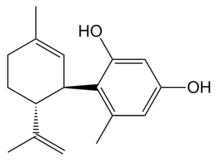O-1602
O-1602 is a synthetic compound most closely related to abnormal cannabidiol, and more distantly related in structure to cannabinoid drugs such as THC. O-1602 does not bind to the classical cannabinoid receptors CB1 or CB2 with any significant affinity, but instead is an agonist at several other receptors which appear to be related to the cannabinoid receptors, particularly GPR18 and GPR55. These previously orphan receptors have been found to be targets for a number of endogenous and synthetic cannabinoid compounds, and are thought to be responsible for most of the non-CB1, non-CB2 mediated effects that have become evident in the course of cannabinoid research. O-1602 produces some effects shared with classical cannabinoid compounds such as analgesic and antiinflammatory effects and appetite stimulation, but it does not produce sedation or psychoactive effects, and has several actions in the gut and brain that are not shared with typical cannabinoid agonists.[1][2][3][4][5][6][7]
 | |
| Identifiers | |
|---|---|
| |
| CAS Number | |
| PubChem CID | |
| IUPHAR/BPS | |
| ChemSpider | |
| Chemical and physical data | |
| Formula | C17H22O2 |
| Molar mass | 258.16 g·mol−1 |
| 3D model (JSmol) | |
| |
| |
See also
References
- Ashton JC (September 2012). "The atypical cannabinoid O-1602: targets, actions, and the central nervous system". Central Nervous System Agents in Medicinal Chemistry. 12 (3): 233–9. doi:10.2174/187152412802430156. PMID 22831390.
- Schuelert N, McDougall JJ (August 2011). "The abnormal cannabidiol analogue O-1602 reduces nociception in a rat model of acute arthritis via the putative cannabinoid receptor GPR55". Neuroscience Letters. 500 (1): 72–6. doi:10.1016/j.neulet.2011.06.004. PMID 21683763.
- Schicho R, Bashashati M, Bawa M, McHugh D, Saur D, Hu HM, et al. (August 2011). "The atypical cannabinoid O-1602 protects against experimental colitis and inhibits neutrophil recruitment". Inflammatory Bowel Diseases. 17 (8): 1651–64. doi:10.1002/ibd.21538. PMC 3116968. PMID 21744421.
- Díaz-Arteaga A, Vázquez MJ, Vazquez-Martínez R, Pulido MR, Suarez J, Velásquez DA, et al. (March 2012). "The atypical cannabinoid O-1602 stimulates food intake and adiposity in rats". Diabetes, Obesity & Metabolism. 14 (3): 234–43. doi:10.1111/j.1463-1326.2011.01515.x. PMID 21981246.
- Kargl J, Haybaeck J, Stančić A, Andersen L, Marsche G, Heinemann A, Schicho R (April 2013). "O-1602, an atypical cannabinoid, inhibits tumor growth in colitis-associated colon cancer through multiple mechanisms". Journal of Molecular Medicine. 91 (4): 449–58. doi:10.1007/s00109-012-0957-1. PMC 3529923. PMID 22965195.
- McHugh D, Wager-Miller J, Page J, Bradshaw HB (July 2012). "siRNA knockdown of GPR18 receptors in BV-2 microglia attenuates N-arachidonoyl glycine-induced cell migration". Journal of Molecular Signaling. 7 (1): 10. doi:10.1186/1750-2187-7-10. PMC 3493281. PMID 22834922.
- Caldwell MD, Hu SS, Viswanathan S, Bradshaw H, Kelly ME, Straiker A (June 2013). "A GPR18-based signalling system regulates IOP in murine eye". British Journal of Pharmacology. 169 (4): 834–43. doi:10.1111/bph.12136. PMC 3687663. PMID 23461720.